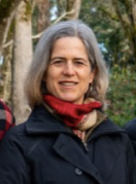
Melissa Redford
Department of Linguistics
University of Oregon
redford@uoregon.edu
website

|
Melissa Redford Department of Linguistics University of Oregon redford@uoregon.edu website |
| Participants: | 188 children - ages 5-11 and 26 adults |
| Type of Study: | narrative |
| Location: | United States |
| Media type: | audio |
Kallay, J., & Redford, M. (2020). Clause-initial AND usage in a cross-sectional and longitudinal corpus of school-age children's narratives. Journal of Child Language, 1-22. doi:10.1017/S0305000920000197
In accordance with TalkBank rules, any use of data from this corpus must be accompanied by the above reference.
See also: Redford, M. A. (2013). A comparative analysis of pausing in child and adult storytelling. Applied Psycholinguistics, 34(3), 569-589.
These data were gathered over a 4-year period, beginning in 2009, as part of a larger study on the acquisition of temporal patterns. Method details for a substantial portion of the data are provided in Kallay and Redford (2020)
The Eugene Children’s Story Corpus (ECSC) includes 367 audio recordings and transcriptions of structured spontaneous narratives elicited from a total of 188 typically-developing school-aged children and 26 adults (accompanying caregiver). The narratives were elicited using Mercer Mayer’s frog story picture books as part of a larger cross-sectional study on the acquisition of temporal patterns. Storytelling was only one of several tasks that the children completed during the study session. Recruitment for the study began in October 2009. Children were between 5 and 8 years old when they first participated in the study. Those who participated in the 3-year longitudinal portion of the study were between 7 and 10 years old at the end of the study. These children returned every year within 2 weeks of the date when they had last participated. This means that children were on average exactly 12 months older in Year 2 of the study than in Year 1, and were again on average exactly 12 months older in Year 3 of the study than in Year 2. Other typically developing school-aged children were also recruited throughout the study period. Data collection was completed during the 2012-13 academic year.
As noted, the stories in ECSC are based on the frog stories. The following books were used: A Boy, a Dog, and a Frog (Mayer, 1967); Frog, Where are You? (Mayer, 1969); Frog on His Own (Mayer, 1973); One Frog Too Many (Mayer & Mayer, 1975). To elicit natural storytelling, children told their story to an accompanying caregiver; caregivers told their story to the child in turn. After a first round of storytelling was complete, another round of storytelling was initiated. The goal of story repetition was to minimize language planning and word-finding effects on the production of narrative prosody in the second elicitation. Only the second story elicitations were transcribed. These are the stories that are being made publicly available.
Note that the audio files are short (~ 2 minutes), and have been cut so that only the narrative in question can be listened to. The files have been de-identified, but the child’s age in months and sex are included in the filename. The study year is also included in the file name. For children who completed the longitudinal portion of the study, the child’s age in months is tied to their first year in the study. The first digit in the 4-digit subject ID number indicates the study year in which children were recruited. A file of individual subject metadata is also included here. This file includes further demographic information and some standardized assessment scores (e.g., PPVT scores).
Please see this link for a general description of the Frog Story methods.
Data collection was supported entirely by a grant from the Eunice Kennedy Shriver National Institute of Child Health & Human Development (NICHD; Award Number R01HD061458; PI: Redford). Many University of Oregon graduate and undergraduate research assistants contributed to the data collection and transcription efforts.